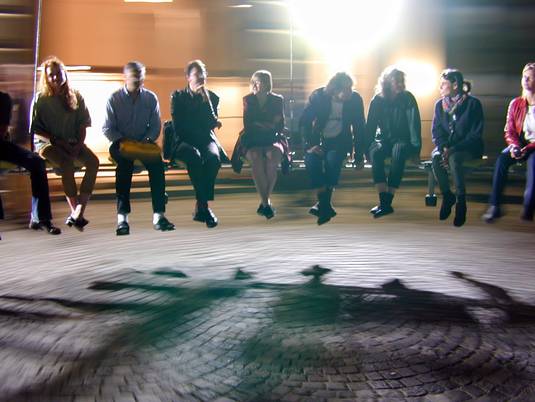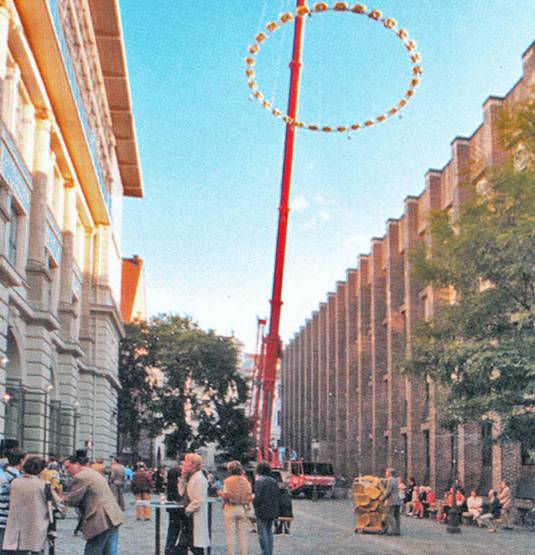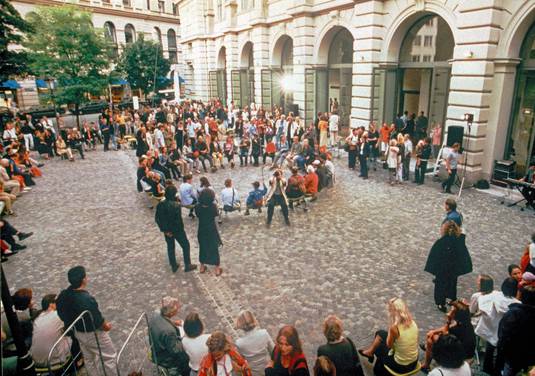Laden und Löschen
Artcircolo, Literaturhaus Munich, 2000
Readings for a floating public
A red, four-axis truck-mounted crane lifts up a ring, on which 32 green seat shells are mounted, with steel cables. But after only a few centimetres, the upward movement stops, and the public take their places in the seating shells, thereby making the ring swing, turn and start moving. One can access the inner circle and swing oneself onto a seat via two mobile stairways, much like airport gangways. Moreover, a stack of individual seats stands ready from which the public can avail themselves and select a place on solid ground. Dispensing with motion is also an option. Empfangshalle has entitled its complex work “Laden und Löschen.” The work functions only together with us, with the public. The process of “Laden,” loading, begins at the moment we mount the ring to take our seat. This is in fact a loading of a work of art with the load of our bodies, and at the same time a metaphor: we load the ring with our personal energy, through our participation we load the work with significance. Something occurs with the work through our loading: the direction of the movement changes according to whether we sit completely still, swing or communicate with other people. The concept of “Löschen” (delete, empty, eliminate) is just as complex: it refers to the unloading of a ship, for instance; here it is the material unloading of the work of art at the moment we leave it. At the same time, we delete our influence on the work, leave no traces, but instead make room for the next participant. The temporary aspect of the work becomes unmistakeably clear through the conceptual pair “Laden und Löschen.” The setting up of the work is also temporary: “Laden und Löschen” takes place at fixed, pre-announced times. Not continually available, it is comparable with the celebration of a ritual, although without a master of ceremonies and with a more or less random public. The by no means everyday return of the event becomes an artistic epiphany of the communicative act represented by the act of taking one’s seat. This impression is supported both by the floating situation of the ring, which is entered as if by gangway stages, as by its form itself: the circle is predestined for ritual events, is the Round table, and much more. But counter-posed to such lofty ambitions, it is here also a swing, inviting one to sway together or opposite each other. Here, Empfangshalle is taking certain considerations further, which have appeared in various ways in their works to date. One central aspect is the approach to the public. Taking the public, luring it as it were with a fun swing, to then have it become, unawares and entirely of its own free will, a part of the sculptural image, is one of Empfangshalle’s long-term guiding concepts. The fun becomes a catalyst of the essential, the sculpture. In the case of “Laden und Löschen,” the crane, the circle of seats and of course, the public combine to form the sculpture. The sculpture is provided with the crane, serving so to speak as a pedestal for an utterly light, simple, even filigree structure, which in turn harmoniously fills out the square’ area and space (whose communicative aspect the theme of the exhibition series Piazza is intended to bring to mind). Perhaps, with “Laden und Löschen,” a harmony can be produced in the coming together and swinging of the public. One can try it out to see for oneself how difficult this is.
Jochen Meister



